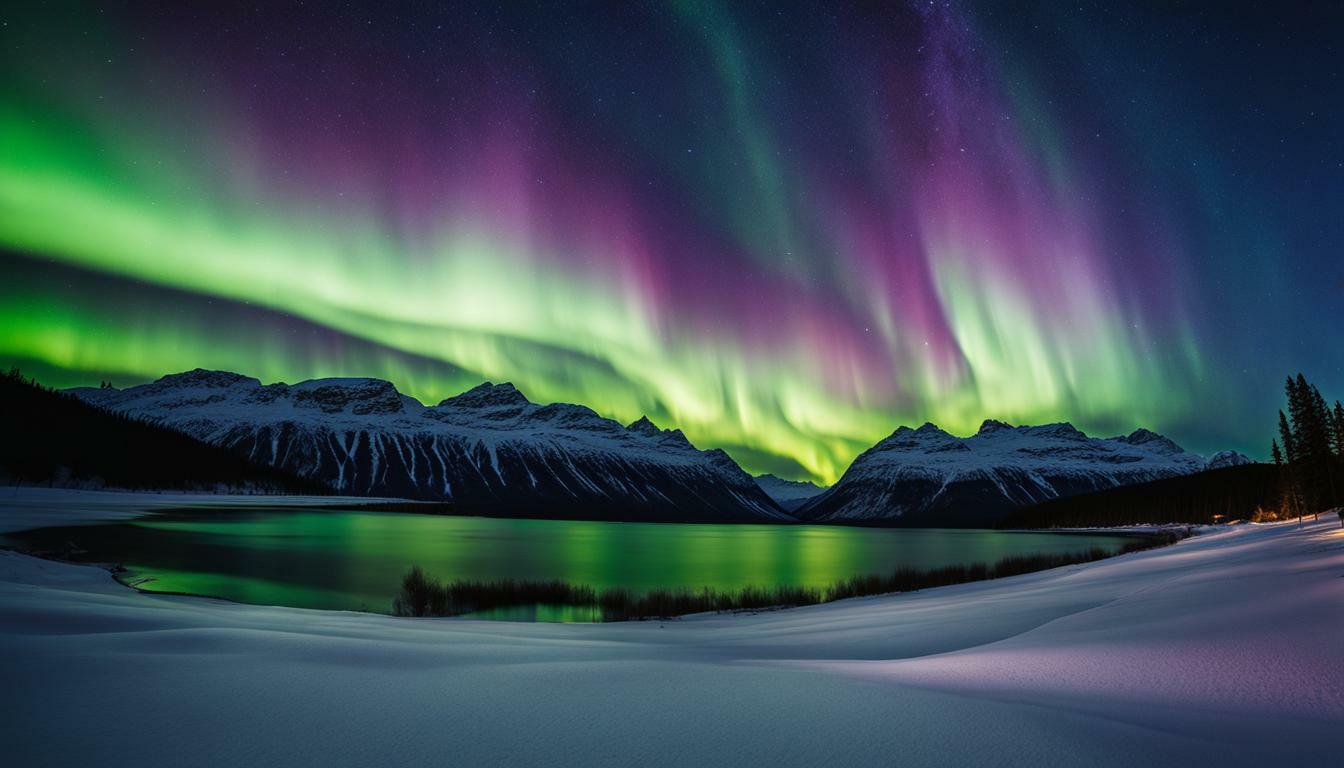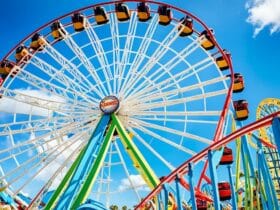If you’re seeking a mesmerizing natural phenomenon, look no further than the Northern Lights. Canada is one of the best places in the world to witness this breathtaking display of dancing lights. Whether you’re a seasoned aurora chaser or a first-time viewer, our ultimate guide will help you plan your dream Northern Lights adventure.
Key Takeaways:
- Canada offers some of the best locations in the world to view the Northern Lights.
- The Aurora Borealis can be seen in various places across Canada, including the Northwest Territories, Yukon, and Nunavut.
- Planning is key to a successful Northern Lights adventure, from choosing the right time of year to selecting the best viewing spots.
- Be prepared for cold weather conditions and bring appropriate clothing and equipment.
- Capturing stunning photographs of the Northern Lights requires a bit of preparation and some basic photography skills.
Canada’s Best Northern Lights Viewing Areas
Canada is home to some of the world’s most spectacular Northern Lights displays, and there are prime spots to witness the aurora borealis across the country. Here are some must-visit spots for Northern Lights viewing in Canada:
| Location | Best Time to Visit | Unique Features |
|---|---|---|
| Yellowknife, Northwest Territories | December to March | Dark skies and wide open spaces |
| Whitehorse, Yukon | December to April | Clear skies and low light pollution |
| Churchill, Manitoba | January to March | Combine Northern Lights viewing with polar bear watching |
| Toronto, Ontario | October to March | Urban Northern Lights viewing experience |
If you’re looking for Canada’s best Northern Lights viewing areas, these destinations are sure to deliver unforgettable experiences. Whether you’re seeking out the perfect place to view the lights or just want to witness this natural wonder for yourself, these prime spots to witness the Northern Lights in Canada are sure to amaze.
Where and When to See Aurora Borealis in Canada
If you’re planning to witness the stunning Northern Lights in Canada, it’s essential to know where and when to go. Although the Aurora Borealis can be seen from many parts of Canada, some locations are better than others. Here are some of the top Canadian destinations for seeing the Northern Lights.
| Destination | Best Time to Visit | Unique Features |
|---|---|---|
| Yellowknife, Northwest Territories | Mid-November to April | Clear skies and low light pollution make for excellent viewing conditions. |
| Whitehorse, Yukon | December to March | The Northern Lights can be seen from the city, and there are also plenty of tours and activities available. |
| Churchill, Manitoba | January to March | Located directly under the Aurora Oval, Churchill has a high probability of Northern Lights sightings. |
| Toronto, Ontario | October to March | You don’t have to venture far from the city to see the Northern Lights. |
It’s important to note that the Aurora Borealis is a natural phenomenon and can be unpredictable. While the above destinations offer some of the best chances of seeing the Northern Lights, there’s no guarantee of a sighting. Weather conditions and solar activity can also affect visibility. However, with a bit of luck and careful planning, you may just witness one of nature’s most mesmerizing displays.
Northern Lights Watching in Canada: Tips and Recommendations
Canada is known for its stunning Northern Lights displays, attracting visitors from around the world. If you are planning a Northern Lights adventure in Canada, here are some tips and recommendations to ensure a successful experience.
Canada’s Northern Lights Hotspots
While the Northern Lights can be seen throughout Canada, there are some key areas where the displays are particularly beautiful. Yellowknife in the Northwest Territories is a popular destination, as is Churchill in Manitoba. Other areas known for their Northern Lights displays include Northern Quebec, Yukon, and Nunavut.
Timing is Everything
To increase your chances of seeing the Northern Lights, it is important to plan your trip for the right time of year. The Northern Lights are most visible between September and March, with peak viewing times in December and January. Keep in mind that the lights are only visible on clear nights without cloud cover.
Dress for Success
Watching the Northern Lights can be a chilly experience, especially in Canada’s colder regions. Make sure to dress warmly with layers, and consider bringing hand and foot warmers. A hat, gloves, and warm waterproof boots are also essential.
Find a Dark Spot
To fully appreciate the Northern Lights, it’s important to find a dark spot away from city lights. Many Northern Lights hotspots offer guided tours to take visitors to the best viewing spots. Alternatively, consider camping in a remote area for an unforgettable experience.
Bring the Right Equipment
To capture the beauty of the Northern Lights with photography, bring a camera with manual settings and a tripod. A wide-angle lens is ideal for capturing the full display. Make sure to bring extra batteries and memory cards, as the cold weather can drain batteries quickly.
By following these tips and recommendations, you can ensure a successful Northern Lights watching experience in Canada.
Planning Your Northern Lights Adventure in Canada
If you’re looking to witness the stunning Northern Lights display in Canada, there are a few practical considerations to keep in mind. Here are some tips to help you plan your adventure:
- Choose your location: As previously mentioned, there are several top locations for seeing the Northern Lights in Canada. Research the specific destinations and choose one that fits your preferences and travel plans.
- Timing is everything: The Northern Lights are visible in Canada from late August to early April. However, the best time to see them is typically between December and February, when the nights are longest.
- Book your accommodations: Once you’ve chosen your destination and timing, it’s important to book your accommodations in advance. Many Northern Lights hotspots offer unique lodging options, such as glass igloos or log cabins, that can enhance your experience.
- Consider transportation: Depending on your chosen location, you may need a rental car or other transportation to get there and explore the area.
By considering these factors and planning ahead, you can maximize your chances of viewing the Northern Lights in all their glory during your Canadian adventure.
Capturing the Northern Lights: Photography Tips
If you’re planning to visit Canada to witness the Northern Lights, capturing the experience through photography is a must. Here are some tips to help you take stunning photos of the Aurora Borealis:
1. Use a tripod
The Northern Lights are best captured on a stable surface, like a tripod. This will prevent any shake or blur in your photos and ensure they come out sharp and clear.
2. Adjust your camera settings
To capture the Northern Lights, use a camera with manual settings and experiment with the different options. Set the aperture to a low f-stop to allow for more light, increase the shutter speed to avoid overexposure, and increase the ISO to pick up the faint detail of the Aurora Borealis.
3. Look for interesting foreground elements
Adding interesting foreground elements to your Northern Lights photos will give them depth and context. Consider including trees, mountains, lakes, or buildings in your shots.
4. Shoot during the Blue Hour
The Blue Hour refers to the time after the sun has set but before it gets completely dark, when the sky takes on a deep blue hue. This is the best time to capture the Northern Lights as it provides the perfect contrast and adds color to the overall scene.
5. Be patient and observant
Photographing the Northern Lights requires a lot of patience and observation. Keep your camera ready at all times and be prepared to wait for the perfect shot. Keep an eye out for any new patterns or changes in the lights, as they can be unpredictable and constantly shifting.
Following these tips will help you capture the Northern Lights in all their glory during your trip to Canada. Make sure to bring plenty of memory cards and an extra battery to avoid missing any shots!
Conclusion
Canada is undoubtedly one of the best places in the world to see the Northern Lights. From the breathtaking views of the Aurora Borealis in the Yukon Territory to the cozy cabins in the Canadian Rockies, there are countless must-visit spots for Northern Lights enthusiasts.
If you’re planning a trip to Canada to see the Northern Lights, make sure to visit some of Canada’s best Northern Lights viewing areas, such as Yellowknife in the Northwest Territories, Jasper National Park in Alberta, and Churchill in Manitoba. These prime spots offer the perfect opportunity to witness the stunning Northern Lights displays that Canada is known for.
When planning your Northern Lights adventure in Canada, consider the best time to visit and what equipment to bring for the best experience. It’s also essential to plan for accommodation and transportation to ensure a comfortable and safe trip.
Lastly, if you’re looking to capture the magic of the Northern Lights in Canada through photography, make sure to read up on some photography tips and techniques to get the best shots.
In conclusion, Canada offers some of the most remarkable Northern Lights displays in the world, making it a must-visit destination for any aurora hunter. With its breathtaking scenery and countless viewing spots, Canada truly is the best place to see the Northern Lights.
FAQ
Where are the best places to view the Northern Lights in Canada?
Canada offers several must-visit spots for witnessing the Northern Lights. Some of the best locations include Yellowknife in Northwest Territories, Churchill in Manitoba, and Whitehorse in Yukon.
When is the best time to see the Aurora Borealis in Canada?
The best time to see the Aurora Borealis in Canada is during the winter months, from October to March. This is when the nights are longer and darker, providing optimal conditions for viewing the Northern Lights.
What are some tips for watching the Northern Lights in Canada?
When watching the Northern Lights in Canada, it’s important to find a dark and open location away from city lights. Dress warmly and be patient, as the lights can sometimes be elusive. Additionally, consider using a camera with manual settings to capture stunning photographs.
How do I plan a Northern Lights adventure in Canada?
When planning your Northern Lights adventure in Canada, be sure to research the best viewing locations and book accommodations in advance. Consider joining organized tours led by experienced guides who know the prime spots for witnessing the Aurora Borealis.
What are some photography tips for capturing the Northern Lights in Canada?
To capture stunning photographs of the Northern Lights in Canada, use a tripod to keep your camera steady, set a long exposure time to capture the motion of the lights, and experiment with different compositions. It’s also recommended to shoot in RAW format for more flexibility during post-processing.





